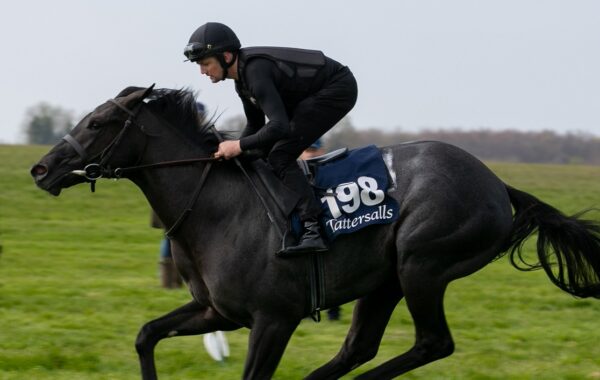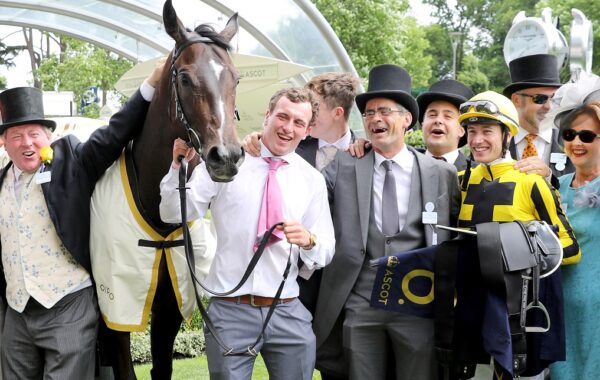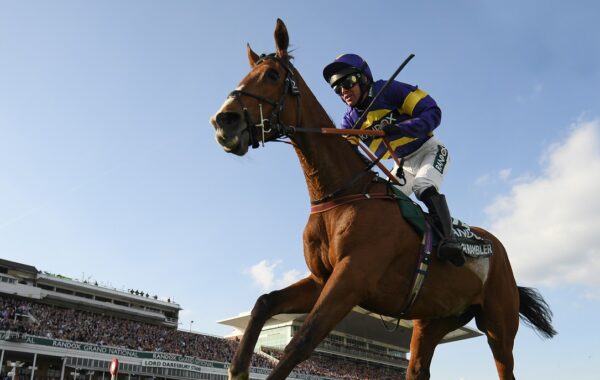Your Classic winners – Look Here, Talent and Simple Verse – are all members of the fairer sex. How do you explain this and do you enjoy training fillies more than colts?
Early on I got to train for a number of owner/breeders and they are inclined to have more fillies in training than colts. It’s not that I really enjoy training fillies more than colts, but it is fair to say that fillies take a bit more thought than colts.
They tend to be more fragile mentally and physically; in a way we followed on from David Elsworth at Whitsbury, a place where he did very well with fillies. That quieter environment definitely suited fillies compared with Lambourn, where I started. Less traffic, motorised or equine, seems to suit their temperaments.
With strong support from a number of owner-breeders, your set-up could be described as ‘old-school’. What are the advantages of this kind of operation?
We have any number of daughters and sons of mares that I trained. It has its obvious advantages, getting to know the family traits and idiosyncrasies. It’s a big help having an idea when a particular brother/sister is likely to be ready to run and in what particular conditions. Owners/breeders are in the game for the long term. They are in a cycle and as long as you’re producing results for them, there is every chance you will stay in the cycle with them.
The aforementioned Simple Verse, in the St Leger, and Secret Gesture, in the Beverly D at Arlington, were involved in highly controversial disqualifications last year. Have their widely publicised cases opened the door for a change in the rules?
Causing interference in a race has recently been changed from “careless” to “improper” riding and carries stiffer penalties, all as a result of what happened last year. The jockeys had been pushing the rules as far as they could. If you give a jockey a longer suspension it’s likely he will take extra care to ride within the rules.
On my way home after the St Leger Sheikh Fahad phoned simply to say, ‘Get the best legal team’
Personally, I’d have cranked up the rule stating that any infringement in the final furlong would automatically result in a double penalty. I would like to have seen that trialled as I’m sure it would result in more jockeys riding within the rules and prevent a lot of what we saw last season, including Colm O’Donoghue leaning on Andrea Atzeni in the St Leger and Andrea leaning back on Colm. Now we must wait and see what the adjustment to the rule brings this season. After our experiences last year it seems nothing should surprise us.
I didn’t know until then that you cannot even appeal against rulings and stewards’ decisions in the states of Kentucky or California. We all know that American racing has disparate rules – but not being able to appeal in every state does seem extraordinary.
It takes skill and planning to win a Classic or Group 1. To have victory taken away must have been hard to swallow. How did events affect you and what did you learn from the experience?
At the time I wouldn’t have been great company, that’s for sure! Apart from anything else we were trying to organise two appeals at the same time and that was pretty testing. The whole experience was pretty draining but at the same time character building and on reflection you realise life must go on.
Sheikh Fahad [owner of Simple Verse and Secret Gesture] was particularly sanguine about the whole episode and backed whatever we decided to do. On my way home after the St Leger he phoned simply to say, ‘Get the best legal team’.
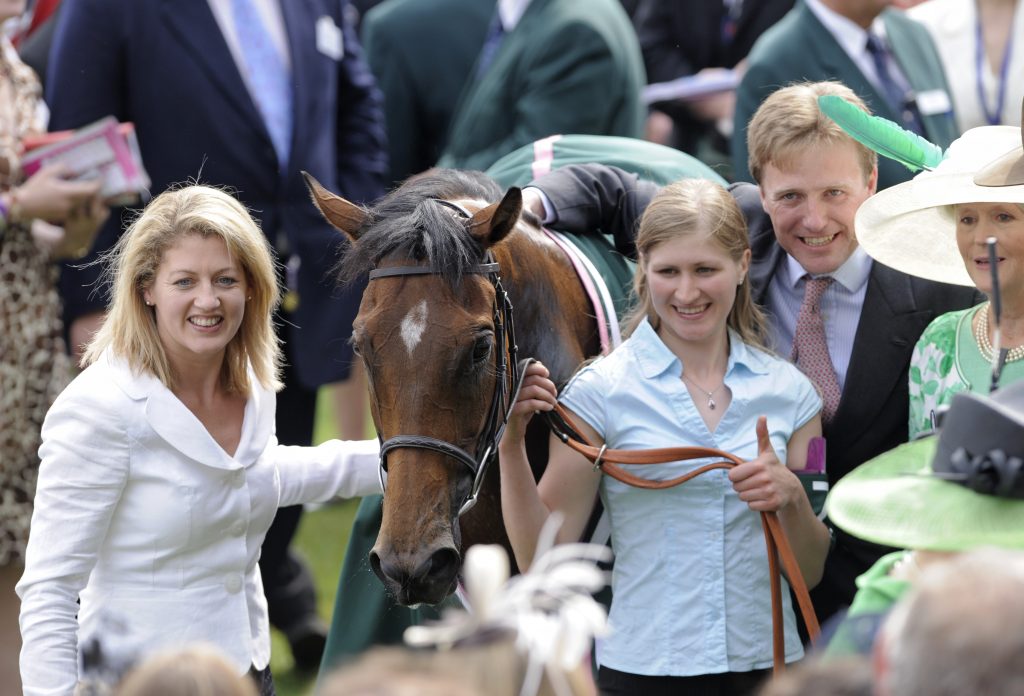
Look Here was Beckett’s first classic winner when she landed the Oaks in 2008
Simple Verse made a pleasing comeback in the Jockey Club Stakes. What are your plans for the season ahead?
In all likelihood she’ll run in the Coronation Cup at Epsom and that would tell us where to go after that. She is likely to have a mid-season break before the Yorkshire Oaks. After that she might step up in trip or go for the Arc and the Fillies & Mares Stakes, which she won last year.
Qatar Racing’s Sheikh Fahad Al Thani is now an enthusiastic rider. Does he ever ride out for you and could you envisage putting him up?
He hasn’t ridden out for me yet. He tends to do that in Newmarket because he has a house there. I would certainly put him up in a charity race. He has become very keen on his hunting as well.
He is planning to ride in that toughest of all races, the Mongolian Derby in August and possibly the Newmarket Town Plate. His enthusiasm is endless; he rang me at ten past ten the other morning to tell me a race had just been reopened.
What role does your wife, Isabelle, play in your training operation and how do you ‘switch off’ from racing?
Izzi is basically in charge of the financial side – mainly because I failed my maths ‘O’ level! – and she also rides out one lot most days. We have two children, Katinka, 11, and Cressie, 6, so Izzi is very busy during the season. But we do get time in winter to pursue our great relaxation together, hunting. Katinka loves it, though Cressie is still a bit young.
You learnt your trade with Jimmy FitzGerald and Peter Walwyn. What important lessons did you take from your time with these two renowned trainers that you have applied in your career?
Jimmy gave us all a thick hide, but, my goodness, he produced some good trainers – Ger Lyons, Brian Ellison, Richard Fahey, John Quinn, who were all at Norton Grange before my time there. He used to tell us he was just knocking the edges off us. His greatest skill was readying a horse for a particular day and he did it many times, memorably with Trainglot on the Flat and over hurdles in the Cesarewitch and Coral Cup.
More than anything else, Peter taught me to think for myself and that was a great help because, in retrospect, when he retired I thought I was too young at 28 to take over the yard, but I had to get on with it. And I did, thanks to him.
In 2011 you purchased Kimpton Down stables, built by Toby Balding. What are the advantages of being there?
Having nobody near you, though I realise Newmarket has other advantages with most of the best bloodstock being trained there. I don’t have to fit in with anyone else; for example, I can use the grass when I want to use it and not wait until I’m told it’s open.
There are advantages with staff when you’re on your own. If they’re here for any length of time they tend to end up being here for a long time. There’s not so much endless moving around of staff that you might find in the big training centres.
You have a new stable jockey, Fran Berry, who has relocated from Ireland. What made you go for him and why is it important to have a retained rider?
Fran was looking to relocate and we started talking last November. He’d never ridden for me and I didn’t know him at the time. But he immediately struck me that he would be an asset because he is a very sympathetic rider, and with the sort of horse we are sent that is an advantage. It quickly became clear after he started that his feedback is excellent.
On top of that he has moved close to the yard and is in here four days a week, which is a big help. We have had agreements with only two other riders, Seb Sanders and Jim Crowley; both were with us for five years. I think a retained rider brings stability to the whole set-up.
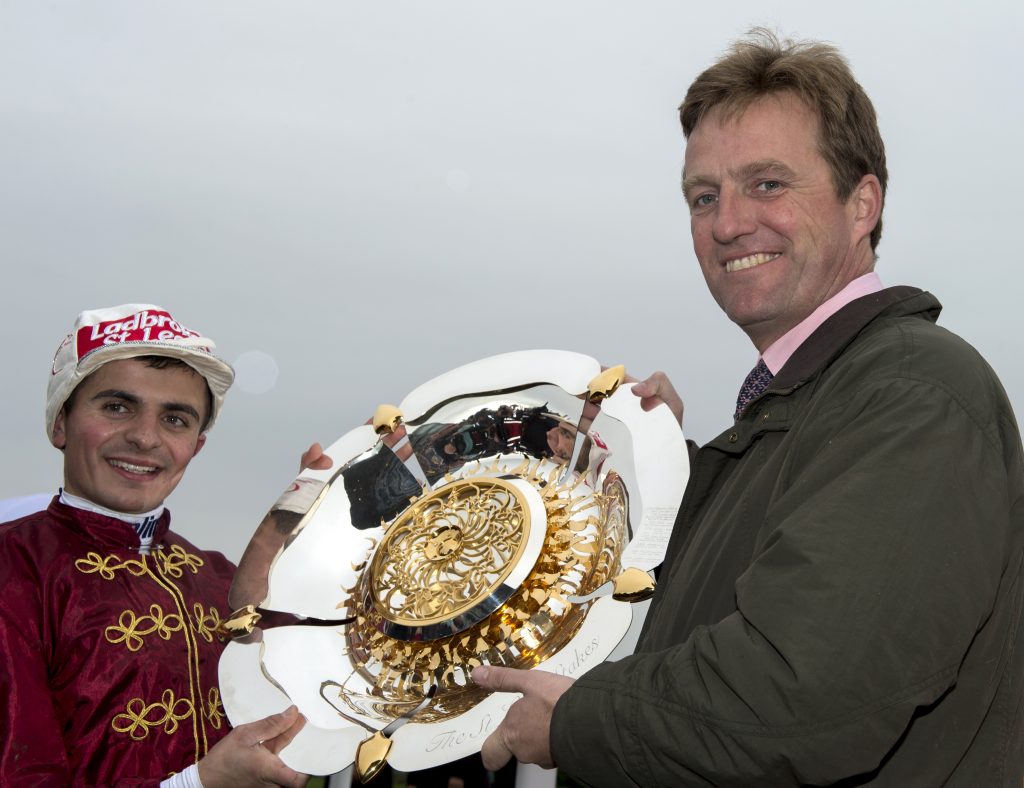
Beckett and Atzeni receiving their prize following the controversial St Ledger victory
You are Chairman of the Central South National Trainers Federation Committee. What does your role involve and do you play a part in other racing politics?
I attend three Council meetings and two regional meetings a year. In the new enlightened era of the BHA, there is a lot more communication with regard to race planning and there are other positives as well. I have had a year on the Horsemen’s Group where I represented the NTF as well. Of course it’s time consuming but somebody’s got to do it, and trainers before me, like William Haggas and Chris Wall, have put in plenty of time.
A big part of the job is communicating with my peers about what’s happening and also to feed back their views to the powers that be. A number of trainers thought that the deadline for reserves for big handicaps was too early and as a result it was pushed back to 1pm from 9.30am.
That was the result of a trainers’ meeting, it got passed on and was implemented. A small example, but a positive one as it provides more chance of a full big-race field after late withdrawals. I have just started on the Race Planning Committee with Seamus Mullins, as well as the likes of Lydia Hislop and Lee Mottershead.
Having re-established the trainers’ title to run from January 1 to December 31, are there any other burning issues you would like to see resolved?
The fixture list has to be sorted out. It has become farcical. There was one day last month when there was one Flat meeting and four jumps. And very importantly racecourses have got to start playing ball, by co-operating rather than doing their own thing. They are not doing the sport any favours. There is the well-known Saturday in July when Newmarket’s July Cup clashes with Ascot, York and Chester, but there are numerous other conflicts.
We’re trying to sell the sport and surely the top jockeys should be able to ride at the best meetings. Equally, how can the sport be televised satisfactorily when so many of the good races are packed together? No Channel 4 TV crew could cover Ascot, Newmarket and York successfully on the same afternoon.
Several Flat courses want to race on Good Friday but only Redcar wants to race on Easter Monday. It doesn’t make sense, though I am heartened by the management changes at the top of Arena, who own 16 of our courses.
You train two talented homebreds – Pacify and Carntop – for the Prince of Wales and Duchess of Cornwall. What are the plans for the year ahead?
The Duchess of Cornwall is hugely enthusiastic and the Prince of Wales is very supportive. Hopefully this will be a year to remember for them. Pacify nearly won the City and Suburban at Epsom and then ran a close second at York’s Dante meeting.
All being well he could go for the Wolferton Handicap at Royal Ascot. Carntop finished a fine second in the Lingfield Derby Trial and has entries in the Derby and King Edward VII Stakes at Ascot.
Do you have any Oaks contenders this year and is it possible to outline your running plans for Royal Ascot?
Diamonds Pour Moi ran well to be third in the Cheshire Oaks, despite not getting the rub of the green. She was the least experienced in the field and is an Oaks possible. Mountain Bell was third in the Oaks Trial at Lingfield and is another possible. Royal Ascot plans could include Chicadoro in the Ribblesdale, Pacify in the Wolferton and Pure Art in the Sandringham.
Moonrise Landing, owned by Peter Savill, looks to be one of the most improved horses in training. How good could she be and what ambitious targets do you have in mind?
She came in season and had to miss the Chester Cup. She had an injury that hindered progress when she was three but has improved massively and done phenomenally well making up for lost time. Given that she won the Listed race at York last month the idea would be to wait for the Melbourne Cup.
On two occasions you have trained 80 winners in a campaign. In your 17th full season training, is the century a realistic target or are you more concerned with quality rather than quantity?
I suppose a century this season is possible but it’s not something I really focus on. My primary aim is always to train more winners than the previous season; we did it last year including the winners abroad. This year on paper we’ve got a better bunch than ever before, certainly among the two-year-olds and of course you’re always looking to improve the quality.
Give us a juvenile, three-year-old and older horse to follow…
The two-year-old is Tropical Rock, who ran well to finish third on her debut at Ascot and goes well at home. The three-year-old is Girling, who won at Bath recently and has plenty of ability. The older horse is Magic Circle, who should keep progressing and might have a nice staying handicap in him.



